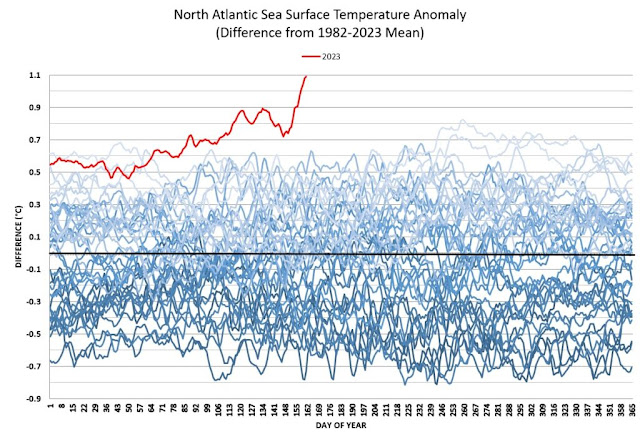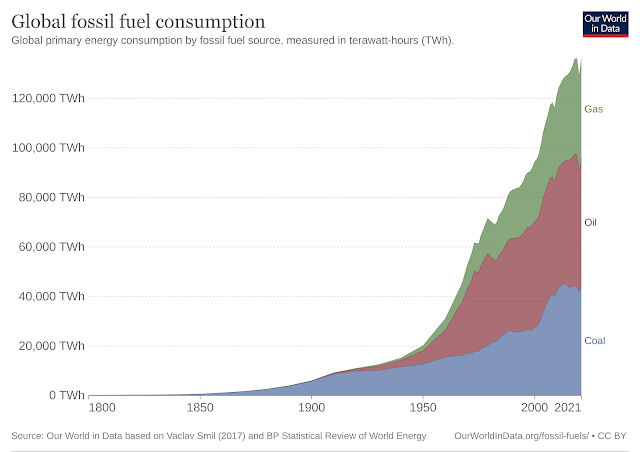The World daily 2-meter Air Temperature (90-90°N, 0-360°E) was 16.77°C on June 9, 2023, an anomaly of 0.9°C for that day. The highest temperature on record is 16.92°C, and it was reached on August 14, 2016, and the anomaly for that day was only 0.75°C.
The record high of 16.92° actually was a tie between August 13, 2016, August 14, 2016, and July 24, 2022. That latter date is important, since the record high temperature was reached even while there was a strong La Niña, suppressing the temperature. This time, we're in an El Niño, so we can expect even higher temperatures over the next few weeks.
The highest anomaly on record was reached on February 28, 2016, when there was a strong El Niño and the anomaly was 1.15°C. Note that these anomalies are compared to the mean temperature for that day in NOAA's NCEP CFSv2.
The above image, from an earlier post, uses monthly NASA Land+Ocean temperature anomalies versus 1886-1915 that are further adjusted by 0.99°C to reflect ocean air temperatures, higher polar anomalies and a pre-industral base.
 |
| [ image credit: WTF is Happening? An Overview - by Eliot Jacobson ] |
The above image shows sea surface temperature on the North Atlantic (0-60°N, 0-80°W) depicted as anomalies, reaching about 1.1°C above the 1982-2023 mean on June 10, 2023.
The situation is especially critical in the North Atlantic, as vast amounts of ocean heat in the North Atlantic are moving toward the Arctic, threatening to cause rapid melting of Arctic sea ice and thawing of permafrost.
The above image shows the same data for sea surface temperature on the North Atlantic (0-60°N, 0-80°W) reaching 22.7°C on June 10, 2023 (on the black line), 0.7°C higher than the 22.0°C on June 10, 2022 (on the orange line).
The comparison with 2022 is important, as the North Atlantic sea surface temperature reached a record 24.9°C on Sept. 4, 2022, even while there was a strong La Niña, suppressing the temperature. This time, we have an El Niño, as illustrated by the NOAA image on the right.
Global sea ice extent was at a record low for the time of year on June 14, 2023, i.e. only 21.42 million km², as illustrated by the image below.
Contributing to this is very low Antarctic sea ice extent. The image below shows Antarctic sea ice extent up to June 14, 2023. Values in the column on the left are for February 16; Antarctic sea ice extent reached a record minimum on February 16, 2023. Values in the column on the right are for June 14. Highlighted are three years: 2023 (red), 2022 (blue) and 2016 (black). Antarctic sea ice extent was also very low at the end of the year 2016, which was a strong El Niño year, yet extent was even lower at the very end of the year in 2022, even though that was during a La Niña.
The annual Arctic sea ice extent minimum is typically reached in September and the North Atlantic sea surface temperature is critical in regard to melting of the Arctic sea ice. The already high sea surface temperature together with the impact of the El Niño make the outlook for Arctic sea ice for September 2023 look grim.
Sea ice concentration is getting lower in many places and there is open water off the Siberian coast and in parts of the Beaufort Sea and Baffin Bay, as illustrated by the Uni of Bremen image on the right. Rising temperatures in the Arctic threaten to trigger massive loss of Arctic sea ice over the coming months.
The image on the right, from polarportal.dk, shows very low Arctic sea ice volume for the time of year on June 13, 2023, already much lower than the volume on the same date for any of the four previous years.
The NASA Worldview satellite image below shows Arctic sea ice in a very vulnerable state on June 11, 2023, even very close to the North Pole (on the left of the image below). Open water is also visible near the Franz Jozef Archipelago, some 1000 km from the North Pole (on the right of the image below).
On the one hand, it's terrible to see open water close to the North Pole so early in the year, yet on the other hand, this may enable ocean heat to escape to the atmosphere and thus delay eruption of seafloor methane (image further below).
The Uni of Bremen image on the right underneath shows Arctic sea ice thickness on June 13, 2023.
As discussed in earlier posts such as this one, conditions are dire:
• Earth's energy imbalance is at record high
• emissions are at record high
• greenhouse gas concentrations are at record high
• temperatures are very high, especially in the Arctic
• emissions are at record high
• greenhouse gas concentrations are at record high
• temperatures are very high, especially in the Arctic
• North Atlantic sea surface temperature is at record high
• sea ice is very vulnerable
• the Jet Stream is strongly deformed, threatening to cause:
• the Jet Stream is strongly deformed, threatening to cause:
• heatwaves extending over the Arctic Ocean with
• hot water from rivers entering the Arctic Ocean, with
• storms pushing hot water into the Arctic Ocean, and with
• fires and storms darkening the sea ice
The image on the right shows that carbon dioxide was as high as 427 ppm recently at Mauna Loa, Hawaii.
The image below shows the extent of the deformation of the Jet Stream on June 6, 2023. No less than 26 circular wind patterns (at 250 hPa) are marked on the image, which also shows sea surface temperature anomalies. The Jet Stream is can also be seen crossing the Equator at the bottom of the image.
Furthermore, there are circumstances that could coincide in a cataclysmic alignment: El Niño is on the way, sunspots are higher than predicted and the Tonga submarine volcano did add large amounts of water vapor high into the atmosphere.
All this looks set to jointly result in massive loss of Arctic sea ice over the coming months, with loss of the latent heat buffer and loss of albedo threatening to trigger eruption of methane from the seafloor of the Arctic Ocean, as has been described many times before, such as in this post, in this post and in this post.
 |
| [ Latent heat loss, feedback #14 on the Feedbacks page ] |
 |
| [ see the Extinction page ] |
In addition, there are further events and developments that could unfold and make things even worse.
The bar on the right depicts the threat, as discussed at the Extinction page.
In conclusion, the situation is dire and calls for support for a Climate Emergency Declaration.
In the video below, Jim Massa is interviewed by Sandy Schoelles about the changes taking place in the oceans.
Links
• Climate Reanalyzer - World Daily 2-meter Air Temperature (90-90°N, 0-360°E)
• NOAA - The National Centers for Environment Prediction Climate Forecast System Version 2
• Pre-industrial
https://climatecasino.net/2023/06/wtf-is-happening-an-overview
• Climate Reanalyzer - Daily sea surface temperatures
https://climatereanalyzer.org/clim/sst_daily
• NOAA - Climate Prediction Center - ENSO Diagnostic Discussions
https://www.cpc.ncep.noaa.gov/products/analysis_monitoring/enso_advisory/ensodisc.shtml
• University of Bremen - sea ice concentration and thickness
https://seaice.uni-bremen.de/start
• Polar Portal - Arctic sea ice thickness and volume
http://polarportal.dk/en/sea-ice-and-icebergs/sea-ice-thickness-and-volume
• NASA Worldview
https://worldview.earthdata.nasa.gov
• Climate Plan
https://arctic-news.blogspot.com/p/climateplan.html
• Climate Emergency Declaration
https://arctic-news.blogspot.com/p/climate-emergency-declaration.html
• Climate Reanalyzer - Daily sea surface temperatures
https://climatereanalyzer.org/clim/sst_daily
• NOAA - Climate Prediction Center - ENSO Diagnostic Discussions
https://www.cpc.ncep.noaa.gov/products/analysis_monitoring/enso_advisory/ensodisc.shtml
• University of Bremen - sea ice concentration and thickness
https://seaice.uni-bremen.de/start
• Polar Portal - Arctic sea ice thickness and volume
http://polarportal.dk/en/sea-ice-and-icebergs/sea-ice-thickness-and-volume
• NASA Worldview
https://worldview.earthdata.nasa.gov
• Wetland emission and atmospheric sink changes explain methane growth in 2020 - by Sushi Peng et al.
https://www.nature.com/articles/s41586-022-05447-w
• Will there be Arctic sea ice left in September 2023?
• Will there be Arctic sea ice left in September 2023?
• Climate Plan
https://arctic-news.blogspot.com/p/climateplan.html
• Climate Emergency Declaration
https://arctic-news.blogspot.com/p/climate-emergency-declaration.html































